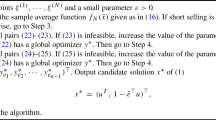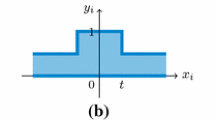Abstract
In this paper we apply modified Newton method based on sample average approximation (SAA) to solve stochastic variational inequality with stochastic second-order cone constraints (SSOCCVI). Under some moderate conditions, the SAA solution converges to its true counterpart with probability approaching one at exponential rate as sample size increases. We apply the theoretical results for solving a class of stochastic second order cone complementarity problems and stochastic programming problems with stochastic second order cone constraints. Some illustrative examples are given to show how the globally convergent method works and the comparison results between our method and other methods. Furthermore, we apply this method to portfolio optimization with loss risk constraints problems.







Similar content being viewed by others
References
Belknap MH, Chen CH, Harker PT (2000) A gradient-based method for analyzing stochastic variational inequalities with one uncertain parameter. OPIM Working Paper 00–03-13. Department of Operations and Information Management, Wharton School, March
Boyd S, Vandenberghe L (2009) Convex optimization. Cambridge University Press, cambridge
Clarke FH (1990) Optimization and nonsmooth analysis, vol 5. SIAM, Philadelphia
Chen B, Chen X, Kanzow C (1997) A penalized Fischer–Burmeister NCP-function: theoretical investigation and numerical results. Inst. für Angewandte Mathematik der Univ
Chen XD, Sun D, Sun J (2003) Complementarity functions and numerical experiments on some smoothing Newton methods for second-order-cone complementarity problems. Comput Optim Appl 25(1–3):39–56
Chen S, Pang LP, Guo FF, Xia ZQ (2012) Stochastic methods based on Newton method to the stochastic variational inequality problem with constraint conditions. Math Comput Model 55(3):779–784
Fukushima M, Luo ZQ, Tseng P (2002) Smoothing functions for second-order-cone complementarity problems. SIAM J Optim 12(2):436–460
Facchinei F, Pang JS (2003) Finite-dimensional variational inequalities and complementarity problems, vol 1. Springer, Berlin
Gürkan G, Yonca Özge A, Robinson SM (1999) Sample-path solution of stochastic variational inequalities. Math Program 84(2):313–333
Jiang H, Xu H (2008) Stochastic approximation approaches to the stochastic variational inequality problem. IEEE Trans Autom Control 53(6):1462–1475
Kleywegt AJ, Shapiro A, Homem-de-Mello T (2002) The sample average approximation method for stochastic discrete optimization. SIAM J Optim 12(2):479–502
Lin GH, Fukushima M (2010) Stochastic equilibrium problems and stochastic mathematical programs with equilibrium constraints: a survey. Pac J Optim 6(3):455–482
Linderoth J, Shapiro A, Wright S (2006) The empirical behavior of sampling methods for stochastic programming. Ann Oper Res 142(1):215–241
Liu Y, Omisch W, Xu H (2014) Quantitative stability analysis of stochastic generalized equations. SIAM J Optim 24(1):467–497
Maggioni F, Potra FA, Bertocchi MI, Allevi E (2009) Stochastic second-order cone programming in mobile ad hoc networks. J Optim Theory Appl 143(2):309–328
Mak WK, Morton DP, Wood RK (1999) Monte Carlo bounding techniques for determining solution quality in stochastic programs. Oper Res Lett 24(1):47–56
Pan S, Chen JS (2010) A semismooth Newton method for SOCCPs based on a one-parametric class of SOC complementarity functions. Comput Optim Appl 45(1):59–88
Shapiro A, Nemirovski A (2004) On complexity of stochastic programming problems. Appl Optim 99: 111–146
Shapiro A, Dentcheva D, Ruszczynski A (2014) Lectures on stochastic programming: modeling and theory, 2nd edn. SIAM
Sun J, Zhang L (2009) A globally convergent method based on Fischer–Burmeister operators for solving second-order cone constrained variational inequality problems. Comput Math Appl 58(10):1936–1946
Xu H (2010) Sample average approximation methods for a class of stochastic variational inequality problems. Asia-Pac J Oper Res 27(01):103–119
Zhang J, Zhang LW, Pang LP (2012) On the convergence of coderivative of saa solution mapping for a parametric stochastic variational inequality. Set-Valued Var Anal 20(1):75–109
Author information
Authors and Affiliations
Corresponding author
Additional information
Partially supported by the Natural Science Foundation of China, Grant 11171049 and 11501074, and the Doctoral Fund of Liaoning Province, Grant 201501194.
Appendix
Appendix
Definition 6.1
A \(\sigma \)-algebra F of subsets of \(\Omega \) is a collection F of subsets of \(\Omega \) satisfying the following conditions:
-
(a)
\(\emptyset \in F\)
-
(b)
if \(B\in F\) then its complement \(B^{c}_{}\) is also in F
-
(c)
if \(B^{}_{1}, B^{}_{2},\ldots \) is a countable collection of sets in F then their union \(\bigcup ^{\infty }_{n=1}B^{}_{n}\).
Definition 6.2
The probability function P , must satisfy several basic axioms:
-
(a)
\(P(B)\ge 0\) for all \(B\in F\)
-
(b)
\(P(\Omega )=1\)
-
(c)
\(P(B\cup C)=P(B)+P(C)\) if \(B\cap C=\emptyset \), for all \(B,\ C\in F\).
Proposition 6.1
(Facchinei and Pang 2003) Let \(f=g\circ G\), where \(G:\ R^{n}_{}\rightarrow R^{m}_{}\) is locally Lipschitz continuous at x and where \(g:\ R^{m}_{}\rightarrow R^{}_{}\) is locally Lipschitz at G(x). Then f is locally Lipschitz continuous at x and
-
(a)
g is continuously differentiable at G(x);
-
(b)
g is C-regular at G(x) and G is continuous differentiable at x (in this case, f is C-regular at x).
Proposition 6.2
(Facchinei and Pang 2003) Let \(G:\ R^{n}_{}\rightarrow R^{m}_{}\) be a locally Lipschitz on an open set \(\Omega \). If \(x\in \Omega \), then
Rights and permissions
About this article
Cite this article
Chen, S., Pang, LP., Ma, XF. et al. SAA method based on modified Newton method for stochastic variational inequality with second-order cone constraints and application in portfolio optimization. Math Meth Oper Res 84, 129–154 (2016). https://doi.org/10.1007/s00186-016-0537-1
Received:
Accepted:
Published:
Issue Date:
DOI: https://doi.org/10.1007/s00186-016-0537-1




